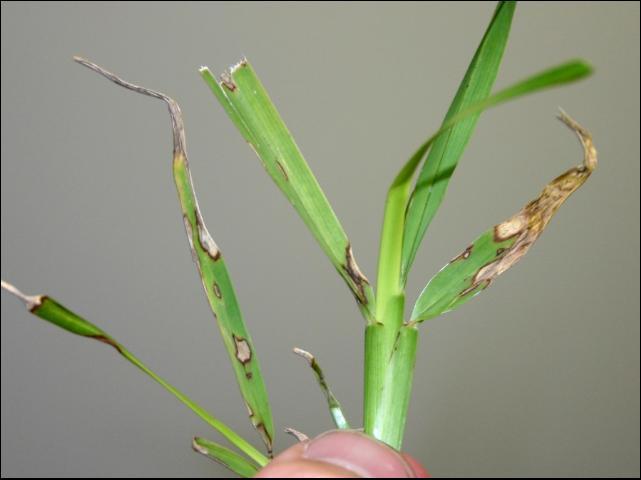
by Larry Williams | Jul 22, 2013
Gray Leaf Spot is a common fungal disease of St. Augustinegrass. Recent wet conditions have promoted this disease. This includes high humidity, heavy dews and particularly frequent afternoon and evening rains.
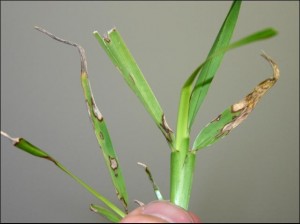
Gray leaf spot symptoms on St. Augustinegrass. Photo credit: UF/IFAS Extension
The individual spots or lesions are first seen as tiny brownish spots smaller than a pinhead. As they become larger, they will be circular and then begin to elongate lengthwise along the leaf. The spots will become brown to grayish in appearance. Numerous spots or lesions may be found on an individual leaf. Heavily infected leaves begin to turn brown and wither, usually beginning at the tip of the blade.
Gray leaf spot can move rapidly during prolonged warm, wet periods. Over watering or irrigating in the evening provides the prolonged period of wetness required for disease infection. For more information on how to correctly water a Florida lawn, visit the UF / IFAS Lawn Watering Website.
According to the Florida Lawn Handbook, “Severity of the disease is enhanced by application of readily available nitrogen fertilizer and is proportional to the amount of nitrogen applied.” Select fertilizers that are low in nitrogen or that have slow release nitrogen. Be careful to not overdo it in fertilizing your lawn and do not apply a high nitrogen fertilizer on top of an already infected lawn. Also, some lawn weed killers such as atrazine will increase the susceptibility of the grass to gray leaf spot.
Irrigate during early morning hours to minimize the period in which the grass is wet and water only on an as needed basis, watering less often but deeply. Avoid frequent, shallow watering and don’t irrigate when the lawn is already wet from rain. With the recent frequent rains, very little to no supplemental irrigation has been needed on most lawns in our area. Avoid leaving irrigation timers on when adequate rainfall has occurred. It’s best to operate irrigation controllers on manual so that the lawn can be monitored and irrigation provided during dry times.
If the disease outbreak is severe, fungicide may be needed. Look for products containing propiconazole, triadimefon or thiophanate-methyl. Always follow the product’s label directions and precautions.
For more information on maintaining a Florida lawn, contact your County UF/IFAS Extension Office or visit the YourFloridaLawn Website.
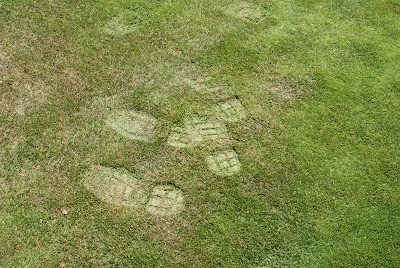
by Taylor Vandiver | Jul 15, 2013
Turfgrass, like all plants, requires water for growth and survival. With the weather we’ve been having lately, watering your lawn is probably the last thing on your mind.

Footprints in turfgrass are a common symptom of drought stress. They are the result of a loss in turgor pressure, due to lack of water, in plant tissue.
However, without sufficient rainfall, water to home lawns will need to be supplemented with irrigation. The most efficient way to irrigate or water your lawn is to apply water only when the lawn starts to show signs of drought stress from lack of moisture.
A few signs associated with drought stress include the changing of turfgrass color from green to a bluish-gray, or white cast. Another sign could be “footprints” on the lawn. If walking across a lawn late in the afternoon causes footprints to be left behind, the lawn may need watering. When feet compress the leaf blades of the turfgrass, the low water levels in the plant tissue prevent the leaf blades from recovering, or “springing” back up, after being pushed down. If the footprints remain for an extended period of time, water the lawn to prevent the turfgrass from turning brown and becoming dormant. The visual condition of the turfgrass can also be used to evaluate drought stress. Turfgrass blades respond to drought stress by folding, rolling, and/or wilting.
A recommended application of ½ to ¾ inch of water can be applied when your turfgrass begins to show the drought stress symptoms discussed previously. Once this amount of water is applied, do not apply again until drought is noticeable. If it rains, like it has been lately, hold off on irrigating until visible drought stress symptoms appear.
Irrigation frequency can vary based on grass species, rainfall amounts, soil type and amount of compaction, shade presence, location, etc. There is a fine line between under and over watering a lawn. Over watering can cause problems such as poor root growth and susceptibility to disease. Over watering can also increase the presence of weed species. When watering, avoid applying water to the point of runoff. Allow the water to soak into the lawn and soil. The optimal time of day to water lawn grass is during the early morning hours. If irrigation is done during the day that water is being lost to higher evaporation rates. Watering in late afternoon or late morning may be detrimental if it extends the time the lawn is naturally wet from dew. This extended “dew period” may increase disease presence in turf.
Automated irrigation systems are convenient, but can have flaws. Always check to make sure your system is working properly and is applying the correct amount of water. However, if significant rainfall has fallen for the week, the automated timed irrigation systems can be turned off so water is not wasted.
Once turf has been watered, it should not be watered again until similar drought stress symptoms are observed. It is never suggested to water your lawn every day, unless it is in the establishment phase or renovations are occuring. Proper watering techniques are key to creating a happy and healthy lawn.
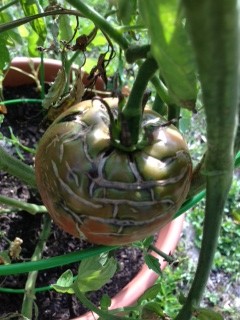
by Mary Salinas | Jul 7, 2013
Imagine this scenario: After you have heavily invested in your tomatoes, cracks appear on your previously perfect fruit just as they are starting to ripen.
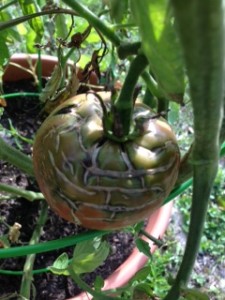
Cracking in Cherokee Purple tomato
Credit: Mary Derrick, UF/IFAS
How frustrating! Depending on the severity of the cracking the fruit will still ripen and be edible, although blemished. However, if cracking is severe, insect and disease pests may take advantage of the weakened skin and feast on the tomato.
Why does this happen?
When tomato plants have fluctuations in the amount of available water in the soil, the skin becomes susceptible to cracking. This occurs when tomatoes are allowed to dry out, then heavily watered. The excess in available moisture causes the inside of the fruit to grow more rapidly than the skin, thus cracking appears. As tomatoes grow toward maturity, they become more prone to cracking. Wide fluctuations in air temperature can also contribute to cracking.
Avoid cracking in your fruit by following these simple suggestions:
• Keep your plants evenly moist through regular irrigation and mulching
• Shade fruit with ample foliage cover
• Select varieties or hybrids that are known to resist cracking
• Harvest susceptible tomatoes at an earlier stage of development and ripen indoors.
Happy Gardening!
For additional information follow these links:
Tomatoes in the Florida Garden
Physiological, Nutritional, and Other Disorders of Tomato Fruit

by Carrie Stevenson | Jul 7, 2013
Floridians use more water than any other state for irrigation, and a typical home sprinkler system can account for half of the cost and water use in a household during the summer.
One of the most convenient and efficient ways to conserve water is to install a rain barrel. Modern rain barrels involve ancient technology that relies simply on gravity, allowing stormwater to run from a rooftop into a gutter. The gutter funnels water into a plastic food-grade barrel or other container fitted with screen to keep out debris and insects. Most rain barrels also have an overflow device near the top (for heavy storms that might fill the barrel) and a spigot at the bottom for filling a watering can or attaching a hose. Keep in mind the barrels do not have a lot of pressure and cannot irrigate an entire lawn, but are ideal for vegetable gardens and container plants. Rain barrels vary widely in design, but they can be painted to add a decorative touch, or easily screened behind a shrub.
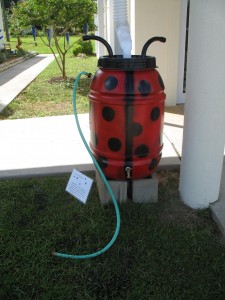
Building a rain barrel is a fun summer project for the whole family!
In addition to conserving water, rain barrels can be an effective means of reducing stormwater pollution. During a typical 1” rainstorm, an average home’s roof can yield 600 gallons of rainwater runoff that would normally flow downstream, picking up oils, greases, bacteria, trash, and pesticides along the way that end up in our water bodies. These pollutants eventually flow downstream to our creeks, bayous, and bays, contributing to non-point source pollution. Rain barrels interrupt that process by collecting stormwater runoff before it has a chance to pick up pollutants.
If you are interested in learning more about rain barrels or how to build your own, contact your local County Extension Office. Escambia County Extension will be hosting two rain barrel workshops this summer, the first on Friday, July 12 and the second on Saturday, August 3. There is a $42 charge for those wishing to build their own rain barrel after the workshop—all supplies and tools will be provided. To register for the full workshop, go online to the event registration website.
It is free to attend and hear the talk without building a barrel, but please reserve a spot by using the contact information below.
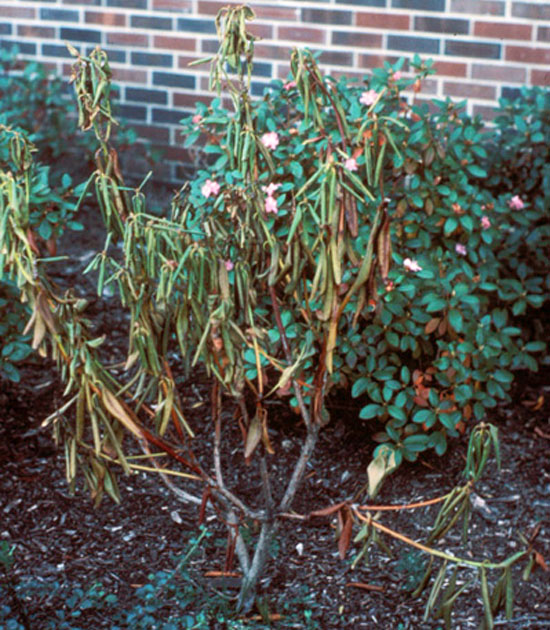
by | Jul 1, 2013
This summer parts of the Florida Panhandle have been blessed with ample rain, but coupled with high temperatures, this can be both a blessing and a curse.
Adequate moisture is critically important to landscape plants during hot weather, but too much rain or excessive watering also can bring problems. Wet soil combined with high temperatures can create stressful conditions for bedding plants, vegetables, shrubs and even trees – especially those just planted this year.
When the soil is saturated with water, pore spaces in the soil, which normally hold air, are filled with water. Since the roots of plants get the oxygen they need from the air in those spaces, the roots can literally drown in a soil that stays waterlogged over an extended period.
In turn, a sick root system leads to a sick plant. Plants in such situations often lose vigor, look wilted, turn yellow, are stunted and often die.

Symptoms of Root Rot on Azalea
Wet soil conditions also encourage fungus organisms that live in the soil to attack the roots or crown of a plant, thus causing rot. The crown is the area where the stem of a plant enters the soil. These disease organisms can cause die-back, inflict severe damage or even kill plants. Worse yet, once infection occurs, little can be done to help a plant affected by these disease organisms.
Plants with succulent stems such as impatiens and begonias, those that like cooler temperatures such as geraniums and dianthus and those that prefer drier, well-drained soils such as Indian Hawthorns are particularly susceptible.
Gardeners can take steps to help alleviate the situation. First , it is critical to adjust irrigation systems that are on automatic timers. Often seen are sprinklers unnecessarily watering at homes or businesses the day after or during a heavy rain simply because the timer turned them on. Turn off the automatic timer if the weather is wet, and turn the system on only when drier conditions occur.
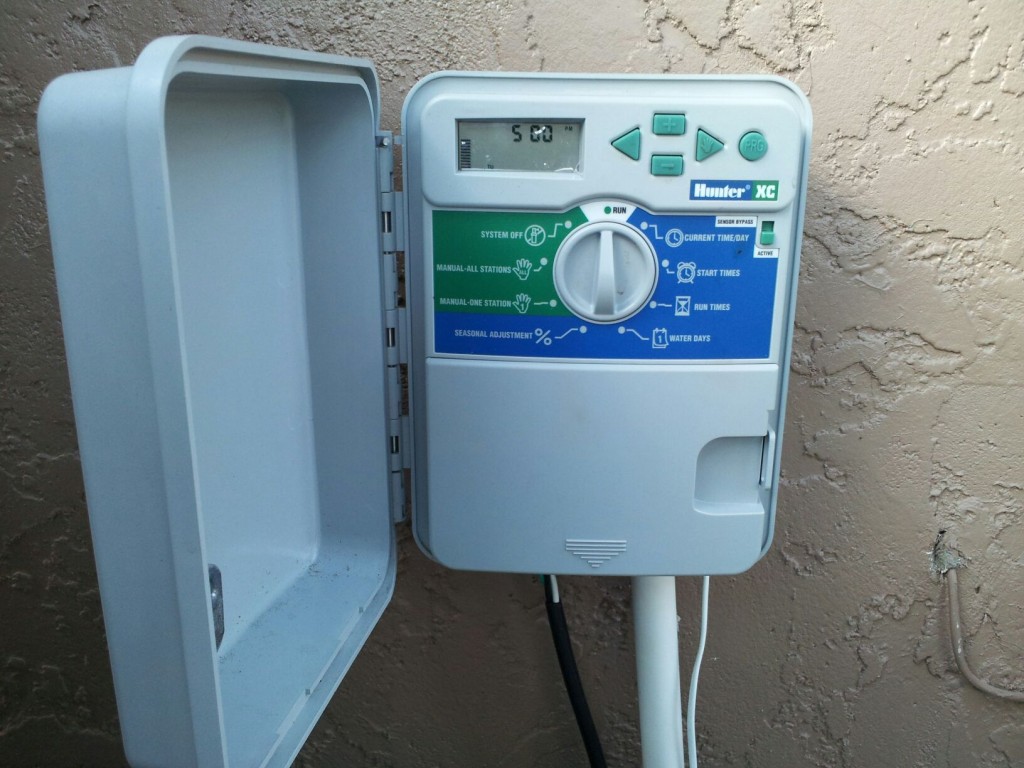
Home Irrigation Timer
Beds should always be well mulched, at 2-4 inches, to control weeds and maintain soil moisture. If garden beds are staying too wet, however, the mulch can be pulled back from around plants or removed entirely to allow the soil to dry faster. Just make sure keep weeds are kept under control while the mulch is off.
Plants affected by wet soils or root rot may look wilted even though the soil is moist. A plant showing these symptoms immediately after a period of prolonged heavy rain may benefit from soil aeration in its root zone. Using a garden fork by driving the tines straight down into the soil and pulling straight out in numerous places around the plant is helpful. This provides air to the roots and encourages the soil to dry faster. Just be sure you don’t dig with the fork.
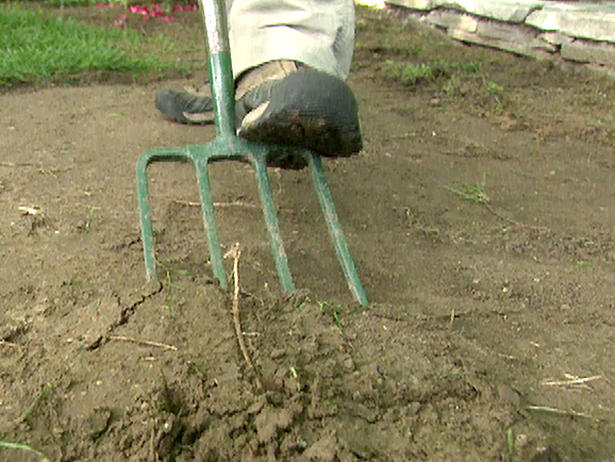
Gardening Fork
Fungal diseases that attack the foliage of many plants also are encouraged by rainy weather. Black spot on roses is prevalent even on fairly resistant varieties, and control is nearly impossible if it rains every afternoon. Cercospora leaf spot and Powdery mildew on crape myrtles can cause the leaves to turn yellow or red and drop off. The disease is not fatal, and the trees will recover without sprays, but flowering may be diminished.
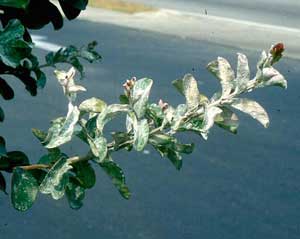
Powdery Mildew on Crape Myrtle
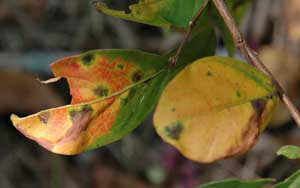
Cercospora Leaf Spot on Crape Myrtle
Other pests such as snails and slugs thrive and reproduce rapidly during rainy weather. These pesky critters chew holes in the leaves and flowers of plants and are particularly fond of soft-leaved plants such as impatiens, begonias and hostas. Try not to let their populations get out of control. Note that Toads should be left alone because they feed on slugs. There also are numerous baits on the market that will help control snails and slugs. You can even place a bowl up to its rim in the ground and fill it half full of beer to attract and drown many snails and slugs.
Frequent rains can leach available nutrients from the soil in the landscape. Landscape plantings should be evaluated with this in mind and be fertilized, if needed. If possible, controlled release fertilizer should be used in this situation. Plants rapidly growing now such as lawn grasses, summer bedding plants and tropicals like ginger and hibiscus are especially vulnerable.













